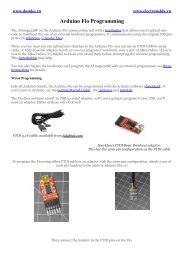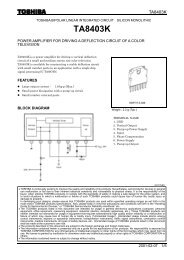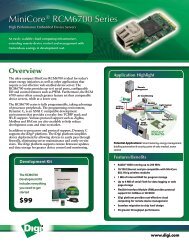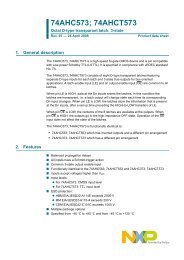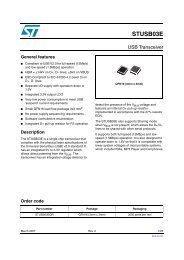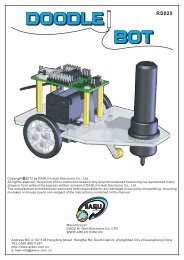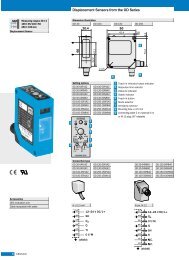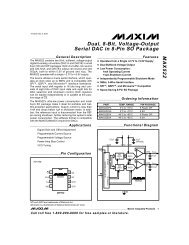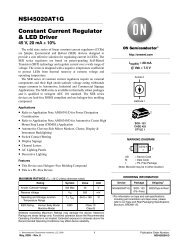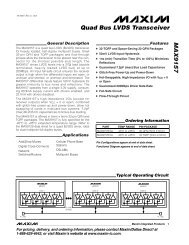3-V to 20-V Integrated FET Hot Swap (Rev. A)
3-V to 20-V Integrated FET Hot Swap (Rev. A)
3-V to 20-V Integrated FET Hot Swap (Rev. A)
Create successful ePaper yourself
Turn your PDF publications into a flip-book with our unique Google optimized e-Paper software.
1<br />
TPS2421-1<br />
TPS2421-2<br />
www.ti.com .................................................................................................................................................. SLUS907A–JANUARY <strong>20</strong>09–REVISED MARCH <strong>20</strong>09<br />
3-V <strong>to</strong> <strong>20</strong>-V <strong>Integrated</strong> <strong>FET</strong> <strong>Hot</strong> <strong>Swap</strong><br />
1FEATURES<br />
2• <strong>Integrated</strong> Pass MOS<strong>FET</strong><br />
DESCRIPTION<br />
• 3.3-V <strong>to</strong> <strong>20</strong>-V Bus Operation The TPS2421 provides highly integrated hot swap<br />
• Programmable Fault Current<br />
power management and superior protection in<br />
applications where the load is powered by voltages<br />
• Current Limit Proportionally Larger than Fault<br />
between 3.0 V and <strong>20</strong> V. These devices are very<br />
Current<br />
effective in systems where a voltage bus must be<br />
• Programmable Fault Timer protected <strong>to</strong> prevent shorts from interrupting or<br />
• Internal MOS<strong>FET</strong> Power Limiting<br />
damaging the unit. The TPS2421 is an easy <strong>to</strong> use<br />
devices in an 8-pin PowerPad SO-8 package.<br />
• Latch-Off on Fault (-1) and Retry (-2) Versions<br />
• SO-8 PowerPad Package<br />
The TPS2421 has multiple programmable protection<br />
features. Load protection is accomplished by a<br />
• –40°C <strong>to</strong> 125°C Junction Temperature Range non-current limiting fault threshold, a hard current<br />
limit, and a fault timer. The current dual thresholds<br />
allow the system <strong>to</strong> draw short high current pulses,<br />
while the fault timer is running, without causing a<br />
APPLICATIONS<br />
• RAID Arrays<br />
• Telecommunications<br />
voltage droop at the load. An example of this is a disk<br />
drive startup. This technique is ideal for loads that<br />
• Plug-In Circuit Boards<br />
experience brief high demand, but benefit from<br />
• Disk Drive protection levels in-line with their average current<br />
draw.<br />
<strong>Hot</strong>swap MOS<strong>FET</strong> protection is provided by power<br />
limit circuitry which protects the internal MOS<strong>FET</strong><br />
against SOA related failures.<br />
The TPS2421 is available in latch-off on fault (-1) and<br />
retry on fault (-2).<br />
3 V <strong>to</strong> <strong>20</strong> V IN<br />
3 VIN<br />
VOUT 7<br />
OUT<br />
(A)<br />
C VIN<br />
(A)<br />
2<br />
EN<br />
FLT 1<br />
GND ISET CT PG<br />
4 5 6 8<br />
R SET<br />
C CT<br />
Optional: To<br />
System Moni<strong>to</strong>r<br />
(A)<br />
C OUT<br />
Figure 1. Typical Application<br />
NOTE:<br />
(A) Required only in systems with lead and/or load inductance.<br />
Please be aware that an important notice concerning availability, standard warranty, and use in critical applications of Texas<br />
Instruments semiconduc<strong>to</strong>r products and disclaimers there<strong>to</strong> appears at the end of this data sheet.<br />
2PowerPad is a trademark of Texas Instruments.<br />
PRODUCTION DATA information is current as of publication date.<br />
Products conform <strong>to</strong> specifications per the terms of the Texas<br />
Instruments standard warranty. Production processing does not<br />
necessarily include testing of all parameters.<br />
Copyright © <strong>20</strong>09, Texas Instruments Incorporated
TPS2421-1<br />
TPS2421-2<br />
SLUS907A–JANUARY <strong>20</strong>09–REVISED MARCH <strong>20</strong>09 .................................................................................................................................................. www.ti.com<br />
ORDERING INFORMATION (1)<br />
DEVICE JUNCTION TEMPERATURE PACKAGE ORDERING CODE MARKING<br />
TPS2421-1 DDA (SO8 PowerPad) TPS2421-1DDA TPS2421-1<br />
–40°C <strong>to</strong> 125°C<br />
TPS2421-2 DDA (SO8 PowerPad) TPS2421-2DDA TPS2421-2<br />
(1) Add an R suffix <strong>to</strong> the device type for tape and reel.<br />
ABSOLUTE MAXIMUM RATINGS<br />
over operating free-air temperature range (unless otherwise noted) (1) (2) VALUE UNIT<br />
V IN , V OUT Input voltage range –0.3 <strong>to</strong> 25<br />
FLT, PG Voltage range –0.3 <strong>to</strong> <strong>20</strong> V<br />
I SET , C T Voltage 1.75<br />
I MAX Maximum continuous output current 9 A<br />
FLT, PG Output sink current 10 mA<br />
EN Input voltage range –0.3 <strong>to</strong> 6<br />
CT, (3) ISET (3) Voltage range -0.3 <strong>to</strong> 3<br />
ESD rating, HBM 2.5 kV<br />
ESD rating, CDM 400 V<br />
T J Operating junction temperature range Internally Limited<br />
T stg S<strong>to</strong>rage temperature range –65 <strong>to</strong> 150<br />
(1) Stresses beyond those listed under absolute maximum ratings may cause permanent damage <strong>to</strong> the device. These are stress ratings<br />
only, and functional operation of the device at these or any other conditions beyond those indicated under recommended operating<br />
conditions is not implied. Exposure <strong>to</strong> absolute-maximum-rated conditions for extended periods may affect device reliability.<br />
(2) All voltage values are with respect <strong>to</strong> GND.<br />
(3) Do not apply voltage <strong>to</strong> these pins.<br />
DISSIPATION RATINGS (1)<br />
PACKAGE θ JA θ JA θ JA<br />
LOW K, °C/W HIGH K, °C/W BEST (2) , °C/W<br />
DDA 190 (3) 45 (4) 45<br />
(1) Tested per JEDEC JESD51, natural convection. The definitions of high-k and low-k are per JESD 51-7 and JESD 51-3.<br />
(2) The best case thermal resistance is obtained using the recommendations per SLMA002A (2 signal – 2 plane with the pad connected <strong>to</strong><br />
the plane).<br />
(3) Low-k (2 signal – no plane, 3 in. by 3 in. board, 0.062 in. thick, 1 oz. copper) test board with the pad soldered, and an additional 0.12<br />
in.2 of <strong>to</strong>p-side copper added <strong>to</strong> the pad.<br />
(4) High-k is a (2 signal – 2 plane) test board with the pad soldered.<br />
RECOMMENDED OPERATING CONDITIONS<br />
V<br />
°C<br />
MIN NOM MAX UNIT<br />
V IN , V OUT Input voltage range 3 <strong>20</strong><br />
EN Voltage range 0 5 V<br />
FLT, PG Voltage range 0 <strong>20</strong><br />
I OUT Continuous output current 0 6 A<br />
FLT, PG Output sink current 0 1 mA<br />
C CT 100 10 pF/µF<br />
Junction temperature –40 125 °C<br />
2 Submit Documentation Feedback Copyright © <strong>20</strong>09, Texas Instruments Incorporated<br />
Product Folder Link(s): TPS2421-1 TPS2421-2
TPS2421-1<br />
TPS2421-2<br />
www.ti.com .................................................................................................................................................. SLUS907A–JANUARY <strong>20</strong>09–REVISED MARCH <strong>20</strong>09<br />
ELECTRICAL CHARACTERISTICS<br />
Unless otherwise noted: 3 V ≤ V IN ≤ 18 V, EN = 0 V, PG = FLT = open, R OUT = open, C LOAD = 0, R SET = 49.9 kΩ, –40°C ≤ T J ≤<br />
125°C<br />
PARAMETER TEST CONDITIONS MIN TYP MAX UNIT<br />
VIN<br />
UVLO VIN rising 2.6 2.85 2.9 V<br />
Hysteresis 150 mV<br />
Bias current EN = 2.4V 25 100 µA<br />
VIN, VOUT<br />
EN = 0V 3.9 5 mA<br />
R VIN-VOUT , I VOUT < I RMAX or<br />
R ON 33 50 mΩ<br />
I VOUT < (I SET × 1.25), 1 A ≤ I VOUT ≤ 4.5 A<br />
Power limit TPS242x V IN : 12 V, C OUT = 1000 µF EN: 3 V → 0 V 3 5 7.5<br />
<strong>Rev</strong>erse diode<br />
voltage<br />
ISET<br />
V OUT > V IN , EN = 5 V, I IN = –1 A 0.77 1.0<br />
I VOUT ↑, I CT : sinking → sourcing, pulsed test<br />
R RSET = <strong>20</strong>0 kΩ 0.80 1.2<br />
0°C ≤ T J ≤ 85°C R RSET = 100 kΩ 1.80 2.2<br />
I SET<br />
Fault current<br />
threshold<br />
R RSET = 49.9 kΩ 3.60 4.40 A<br />
R RSET = <strong>20</strong>0 kΩ 0.75 1.25<br />
-40°C ≤ T J ≤ 125°C R RSET = 100 kΩ 1.75 2.25<br />
R RSET = 49.9 kΩ 3.60 4.40<br />
R RSET = <strong>20</strong>0 kΩ 1.1 1.8 2.6<br />
I LIM /<br />
Ratio I LIM / I FLT R RSET = 100 kΩ 1.1 1.5 2.1<br />
I FLT –<br />
R RSET = 49.9 kΩ 1.1 1.4 1.6<br />
R RSET = <strong>20</strong>0 kΩ 1.1 1.8 2.4<br />
I LIM Current limit I VOUT rising, V VIN-VOUT = 0.3 V, pulsed test R RSET = 100 kΩ 2.3 3.0 3.7<br />
CT<br />
R RSET = 49.9 kΩ 4.6 5.5 6.3<br />
Charge/discharge I CT sourcing, V CT = 1 V, In current limit 29 35 41<br />
current I CT sinking, V CT = 1 V, drive CT <strong>to</strong> 1 V, measure current 1.0 1.4 1.8<br />
Threshold voltage<br />
ON/OFF fault duty<br />
cycle<br />
V CT rising 1.3 1.4 1.5<br />
V CT falling, drive CT <strong>to</strong> 1 V, measure current 0.1 0.16 0.3<br />
V VOUT = 0 V 2.8% 3.7% 4.6%<br />
V<br />
µA<br />
V<br />
Copyright © <strong>20</strong>09, Texas Instruments Incorporated Submit Documentation Feedback 3<br />
Product Folder Link(s): TPS2421-1 TPS2421-2
TPS2421-1<br />
TPS2421-2<br />
SLUS907A–JANUARY <strong>20</strong>09–REVISED MARCH <strong>20</strong>09 .................................................................................................................................................. www.ti.com<br />
ELECTRICAL CHARACTERISTICS (continued)<br />
Unless otherwise noted: 3 V ≤ V IN ≤ 18 V, EN = 0 V, PG = FLT = open, R OUT = open, C LOAD = 0, R SET = 49.9 kΩ, –40°C ≤ T J ≤<br />
125°C<br />
PARAMETER TEST CONDITIONS MIN TYP MAX UNIT<br />
EN<br />
Threshold voltage<br />
V EN falling 0.8 1.0 1.5 V<br />
Hysteresis <strong>20</strong> 150 250 mV<br />
VEN = 2.4 V –2.0 0 0.5<br />
Input bias current µA<br />
VEN = 0.2 V –3.0 1 0.5<br />
Turn on propagation V IN = 3.3 V, I LOAD = 1 A, V EN : 2.4 V → 0.2 V,<br />
350 500<br />
delay V OUT : rising 90% × V IN<br />
µs<br />
Turn off propagation V IN = 3.3 V, I LOAD = 1 A, V EN : 0.2 V → 2.4 V,<br />
30 50<br />
delay<br />
V OUT : ↓ 10% × V IN<br />
FLT<br />
Low level output<br />
V OL V CT = 1.8 V, I FLT = 1 mA 0.2 0.4 V<br />
voltage<br />
Leakage current V FLT = 18 V 1 µA<br />
PG<br />
PG threshold<br />
V (VIN-VOUT) falling 0.4 0.5 0.75<br />
Hysteresis 0.1 0.25 0.4<br />
Low level output<br />
V OL I PG = 1 mA 0.2 0.4<br />
voltage<br />
Leakage current V PG = 18 V 1 µA<br />
Thermal Shutdown<br />
T SD Thermal shutdown Junction temperature rising 160<br />
Hysteresis 10<br />
V<br />
°C<br />
4 Submit Documentation Feedback Copyright © <strong>20</strong>09, Texas Instruments Incorporated<br />
Product Folder Link(s): TPS2421-1 TPS2421-2
TPS2421-1<br />
TPS2421-2<br />
www.ti.com .................................................................................................................................................. SLUS907A–JANUARY <strong>20</strong>09–REVISED MARCH <strong>20</strong>09<br />
BLOCK DIAGRAM<br />
VIN<br />
GND<br />
3<br />
4<br />
V(DS) Detec<strong>to</strong>r<br />
+<br />
<br />
-<br />
Constant<br />
Power<br />
Engine<br />
Q<br />
Pump<br />
10 A<br />
I OUT<br />
1<br />
I(D)<br />
Detec<strong>to</strong>r<br />
7<br />
VOUT<br />
0.8R<br />
Fast<br />
Trip<br />
LCA<br />
+<br />
+<br />
1.6 x I LIM<br />
1.0V<br />
+<br />
R<br />
0.2R<br />
+<br />
ISET<br />
CT<br />
5<br />
6<br />
34 A<br />
FLT<br />
+<br />
CT<br />
Charge<br />
I OUT ______<br />
<strong>20</strong>0 k<br />
1.35 V<br />
PWRG<br />
+<br />
THERMAL<br />
SHUTDOWN<br />
S<br />
R<br />
Q<br />
Q<br />
FLT<br />
LATCH -1<br />
FACTORY<br />
SET<br />
1.25 A<br />
33 A<br />
<strong>20</strong>0 mV<br />
+<br />
RETRY -2<br />
EN<br />
2<br />
1.5V<br />
+<br />
PWRG<br />
V OUT<br />
8<br />
PG<br />
VIN<br />
2.7 / 2.6<br />
+<br />
Internal Rail<br />
+<br />
V IN<br />
-500mV<br />
PINOUT DIAGRAM<br />
TPS2421-x<br />
1<br />
FLT<br />
PG<br />
8<br />
2<br />
EN<br />
VOUT<br />
7<br />
3<br />
VIN<br />
CT<br />
6<br />
4 GND<br />
ISET 5<br />
Copyright © <strong>20</strong>09, Texas Instruments Incorporated Submit Documentation Feedback 5<br />
Product Folder Link(s): TPS2421-1 TPS2421-2
TPS2421-1<br />
TPS2421-2<br />
SLUS907A–JANUARY <strong>20</strong>09–REVISED MARCH <strong>20</strong>09 .................................................................................................................................................. www.ti.com<br />
PIN DESCRIPTION<br />
C<br />
CT<br />
T<br />
<br />
38 9 10<br />
FAULT<br />
3<br />
. <br />
(1)<br />
6<br />
T<br />
SD<br />
1. 0 10 CCT<br />
Table 1. TERMINAL FUNCTIONS<br />
FUNCTION PIN NO. DESCRIPTION<br />
FLT 1 Fault low indicated the fault time has expired and the <strong>FET</strong> is switched off<br />
EN 2 Device is enabled when this pin is pulled low<br />
VIN 3 Power In and control supply voltage<br />
GND 4 GND<br />
ISET 5 A resis<strong>to</strong>r <strong>to</strong> ground sets the fault current, the current limit is 125% of the fault current. TPS2421 only<br />
CT 6 A capaci<strong>to</strong>r <strong>to</strong> ground sets the fault time<br />
VOUT 7 Output <strong>to</strong> the load<br />
PG 8 Power Good low represents the output voltage is within 300 mV of the input voltage<br />
CT: Connect a capaci<strong>to</strong>r form CT <strong>to</strong> GND <strong>to</strong> set the fault time. The fault timer starts when the fault current<br />
threshold is exceeded, charging the capaci<strong>to</strong>r with 36 µA from GND <strong>to</strong>wards an upper threshold of 1.4 V. If the<br />
capaci<strong>to</strong>r reaches the upper threshold, the internal pass MOS<strong>FET</strong> is turned off. The MOS<strong>FET</strong> will stay off until<br />
EN is cycled if a latching version is used. If an au<strong>to</strong>-retry version is used, the capaci<strong>to</strong>r will discharge at 5 µA <strong>to</strong><br />
0.2 V and then re-enable the pass MOS<strong>FET</strong>. When the device is disabled, CT is pulled <strong>to</strong> GND through a<br />
100-kΩ resis<strong>to</strong>r.<br />
The timer period must be chosen long enough <strong>to</strong> allow the external load capacitance <strong>to</strong> charge. The fault timer<br />
period is selected using Equation 1 where T FAULT is the minimum timer period in seconds and C CT is in Farads.<br />
This equation does not account for component <strong>to</strong>lerances. In au<strong>to</strong>retry versions, the second and subsequent<br />
retry timer periods will be approximately 85% as long as the first retry period.<br />
In au<strong>to</strong>retry versions, the fault timer discharges the capaci<strong>to</strong>r for a nominal T SD in seconds with C CT in Farads per<br />
Equation 2.<br />
The nominal ratio of on <strong>to</strong> off times represents about a 3% duty cycle when a hard fault is present on the output<br />
of an au<strong>to</strong>retry version part.<br />
FLT: Open-drain output that pulls low on any condition that causes the output <strong>to</strong> open. These conditions are<br />
either an overload with a fault time-out, or a thermal shutdown. FLT becomes operational before UV, when V IN is<br />
greater than 1 V.<br />
GND: This is the most negative voltage in the circuit and is used as reference for all voltage measurements<br />
unless otherwise specified.<br />
ISET: A resis<strong>to</strong>r from this pin <strong>to</strong> GND sets both the fault current (I FAULT ) and current limit (I MAX ) levels. The<br />
current limit is internally set at 125% of the fault current. The fault timer function on C T starts charging C T if I VIN<br />
exceeds the programmed fault current. If this current continues long enough for V CT <strong>to</strong> reach its upper trip<br />
threshold, the output is turned off. If I VIN falls below the fault current threshold before C T reaches its upper<br />
threshold, C T is discharged and normal operation continues.<br />
The internal MOS<strong>FET</strong> actively limits current if I VIN reaches the current limit set point. The fault timer operation is<br />
the same in this mode as described previously.<br />
The fault current value is programmed as follows;<br />
k<br />
R IFLT <strong>20</strong>0 I FAULT<br />
(3)<br />
(2)<br />
6 Submit Documentation Feedback Copyright © <strong>20</strong>09, Texas Instruments Incorporated<br />
Product Folder Link(s): TPS2421-1 TPS2421-2
TPS2421-1<br />
TPS2421-2<br />
www.ti.com .................................................................................................................................................. SLUS907A–JANUARY <strong>20</strong>09–REVISED MARCH <strong>20</strong>09<br />
EN: When this pin is pulled low, the device is enabled. The input threshold is hysteretic, allowing the user <strong>to</strong><br />
program a startup delay with an external RC circuit. EN is pulled <strong>to</strong> V IN by a 10-MΩ resis<strong>to</strong>r, pulled <strong>to</strong> GND by<br />
16.8 MΩ and is clamped <strong>to</strong> ground by a 7-V Zener diode. Because high impedance pullup/down resis<strong>to</strong>rs are<br />
used <strong>to</strong> reduce current draw, any external <strong>FET</strong> controlling this pin should be low leakage.<br />
If EN is tied <strong>to</strong> GND at startup and V IN does not ramp quickly the TPS2421 may momentarily turn off then on<br />
during startup. This can happen if a capacitive load momentarily pulls down the input voltage below the UV<br />
threshold. If necessary, this can be avoided by delaying EN assertion until V IN is fully up.<br />
V IN : Input voltage <strong>to</strong> the TPS2421. The recommended operating voltage range is 3 V <strong>to</strong> <strong>20</strong> V. All VIN pins should<br />
be connected <strong>to</strong>gether and <strong>to</strong> the power source.<br />
V OUT : Output connection for the TPS2421. When switched on the output voltage will be approximately:<br />
V V 0. 04 I<br />
OUT IN OUT<br />
All V OUT pins should be connected <strong>to</strong>gether and <strong>to</strong> the load.<br />
PG: Active low, Open Drain output, Power Good indicates that there is no fault condition and the output voltage<br />
is within 0.5 V of the input voltage. PG becomes operational before UV, whenever V IN is greater than 1 V.<br />
(4)<br />
Copyright © <strong>20</strong>09, Texas Instruments Incorporated Submit Documentation Feedback 7<br />
Product Folder Link(s): TPS2421-1 TPS2421-2
TPS2421-1<br />
TPS2421-2<br />
SLUS907A–JANUARY <strong>20</strong>09–REVISED MARCH <strong>20</strong>09 .................................................................................................................................................. www.ti.com<br />
FAULT CURRENT<br />
vs<br />
JUNCTION TEMPERATURE<br />
TYPICAL CHARACTERISTICS<br />
FAULT TIMER THRESHOLD VOLTAGE<br />
vs<br />
JUNCTION TEMPERATURE<br />
2.<strong>20</strong><br />
1.50<br />
I FAULT<br />
– Fault Current – A<br />
2.15<br />
2.10<br />
2.50<br />
2.00<br />
1.95<br />
1.90<br />
1.85<br />
R FLT<br />
= 100 kW<br />
V THRESH<br />
– Fault Timer Threshold Voltage -– V<br />
1.45<br />
1.40<br />
1.35<br />
1.80<br />
–50 0 50 100 150<br />
1.30<br />
–50 0 50 100 150<br />
T J<br />
– Junction Temperature – °C<br />
POWER LIMIT<br />
vs<br />
JUNCTION TEMPERATURE<br />
T J<br />
– Junction Temperature – °C<br />
Figure 2. Figure 3.<br />
SUPPLY CURRENT<br />
vs<br />
JUNCTION TEMPERATURE<br />
P LIMIT<br />
– Power Limit Level – W<br />
8.0<br />
7.5<br />
7.0<br />
6.5<br />
6.0<br />
5.5<br />
5.0<br />
4.5<br />
4.0<br />
3.5<br />
I LOAD<br />
= 1 A<br />
I SUPPLY<br />
– Supply Current – mA<br />
24<br />
22<br />
<strong>20</strong><br />
18<br />
16<br />
14<br />
12<br />
Sleep Mode<br />
3.0<br />
–50 0 50 100 150<br />
10<br />
–50 0 50 100 150<br />
T J<br />
– Junction Temperature – °C<br />
T J<br />
– Junction Temperature – °C<br />
Figure 4. Figure 5.<br />
8 Submit Documentation Feedback Copyright © <strong>20</strong>09, Texas Instruments Incorporated<br />
Product Folder Link(s): TPS2421-1 TPS2421-2
TPS2421-1<br />
TPS2421-2<br />
www.ti.com .................................................................................................................................................. SLUS907A–JANUARY <strong>20</strong>09–REVISED MARCH <strong>20</strong>09<br />
TYPICAL CHARACTERISTICS (continued)<br />
PG<br />
PG<br />
EN<br />
12 V Startup in<strong>to</strong> 15 , 700 F Load<br />
VCT<br />
R SET<br />
= 49.9 k<br />
ILOAD<br />
VOUT<br />
ILOAD<br />
VOUT<br />
Temp capacitive overload, power limit<br />
tripped<br />
12-V load at 1.5 A, then 140 F added <strong>to</strong><br />
load<br />
R SET<br />
= 49.9 k<br />
Figure 6. 12-V Startup In<strong>to</strong> 15 Ω, 700 µF Load<br />
Figure 7. 12-V, 140 µF Added <strong>to</strong> 8 Ω Load<br />
VIN<br />
12-V failed startup in 4 0 F load<br />
PG<br />
EN<br />
VCT<br />
ILOAD<br />
FLT<br />
Soft overload, power limit not tripped,<br />
12-V load stepped from 3 A <strong>to</strong> 4.2 A,<br />
C LOAD<br />
= 700 F, R SET<br />
= 49.9 k<br />
VOUT<br />
VOUT<br />
Figure 8. 12-V Faulted Startup In<strong>to</strong> 4 Ω Load<br />
Figure 9. 12-V Soft Overload, 3 A <strong>to</strong> 4.2 A, Power Limit Not<br />
Tripped<br />
Copyright © <strong>20</strong>09, Texas Instruments Incorporated Submit Documentation Feedback 9<br />
Product Folder Link(s): TPS2421-1 TPS2421-2
TPS2421-1<br />
TPS2421-2<br />
SLUS907A–JANUARY <strong>20</strong>09–REVISED MARCH <strong>20</strong>09 .................................................................................................................................................. www.ti.com<br />
TYPICAL CHARACTERISTICS (continued)<br />
PG<br />
PG<br />
VCT<br />
VCT<br />
ILOAD<br />
Overload, power limit tripped,<br />
12-V load stepped from 3 A <strong>to</strong> 5.4 A,<br />
C LOAD<br />
= 700 F, R SET<br />
= 49.9 k<br />
ILOAD<br />
12-V load at 3.6 A, then short applied<br />
<strong>to</strong> output, R SET<br />
= 49.9 k<br />
VOUT<br />
VOUT<br />
Figure 10. 12-V Firm Overload, 3 A <strong>to</strong> 5.4 A, Power Limit<br />
Tripped<br />
Figure 11. 12-V Hard Overload, 3.6-A LoaD Then Short<br />
12-V P LIM<br />
during startup in<strong>to</strong> 60 , 800<br />
F<br />
R SET<br />
= 49.9 k<br />
P dissipation internal <strong>FET</strong><br />
R FLT<br />
=<br />
ILOAD<br />
100 k<br />
12-V P LIM<br />
during startup in<strong>to</strong><br />
overload, CT = 0.1 F<br />
R SET<br />
= 49.9 k<br />
VOUT<br />
CT<br />
VOUT<br />
P dissipation internal <strong>FET</strong><br />
ILOAD<br />
Figure 12. Power Dissipation During 12-V Startup in<strong>to</strong> 60 Figure 13. Power Dissipation During 12-V Startup in<strong>to</strong> 15<br />
Ω, 800 µF Ω, 140 µF<br />
10 Submit Documentation Feedback Copyright © <strong>20</strong>09, Texas Instruments Incorporated<br />
Product Folder Link(s): TPS2421-1 TPS2421-2
TPS2421-1<br />
TPS2421-2<br />
www.ti.com .................................................................................................................................................. SLUS907A–JANUARY <strong>20</strong>09–REVISED MARCH <strong>20</strong>09<br />
TYPICAL CHARACTERISTICS (continued)<br />
PG<br />
PG<br />
EN<br />
3 V startup in<strong>to</strong> 3.2 A load<br />
R SET<br />
= 49.9 k<br />
VCT<br />
ILOAD<br />
ILOAD<br />
3.3 V overload step from 3.8 A <strong>to</strong> 5.5<br />
A, R SET<br />
= 49.9 k<br />
VOUT<br />
VOUT<br />
Figure 14. 3-V Startup in<strong>to</strong> 1-Ω Load<br />
Figure 15. 3-V Firm Overload, Load Stepped From 3.8 A <strong>to</strong><br />
5.5 A<br />
PG<br />
FLT<br />
VCT<br />
VCT<br />
ILOAD<br />
3.3 V overload step from 3.8 A <strong>to</strong> 7.1<br />
A, R SET<br />
= 49.9 k<br />
ILOAD<br />
3.3 V overload shorted while under 3.5<br />
A load, R SET<br />
= 49.9 k<br />
VOUT<br />
VOUT<br />
Figure 16. 3-V Hard Overload, Load Stepped From 3.8 A <strong>to</strong><br />
7.1 A<br />
Figure 17. 3-V Output Shorted While Under 3.5-A Load<br />
Copyright © <strong>20</strong>09, Texas Instruments Incorporated Submit Documentation Feedback 11<br />
Product Folder Link(s): TPS2421-1 TPS2421-2
TPS2421-1<br />
TPS2421-2<br />
SLUS907A–JANUARY <strong>20</strong>09–REVISED MARCH <strong>20</strong>09 .................................................................................................................................................. www.ti.com<br />
TYPICAL CHARACTERISTICS (continued)<br />
PG<br />
EN<br />
3.3 V attempting startup in<strong>to</strong> 1 W,<br />
2<strong>20</strong>0 F load, retry mode - CT = 0.1 F<br />
R SET<br />
= 49.9 k<br />
VCT<br />
VCT<br />
ILOAD<br />
ILOAD<br />
3.3 V, 1600 F added while under 3.5<br />
A load, R SET<br />
= 49.9 k<br />
VOUT<br />
VOUT<br />
Figure 18. 3 V, 1600 µF Added To 3.5-A Load<br />
Figure 19. 3-V Retry Startup in<strong>to</strong> 1 Ω, 2<strong>20</strong>0-µF Load<br />
Figure <strong>20</strong>. Startup In<strong>to</strong> a Short Circuit Output<br />
12 Submit Documentation Feedback Copyright © <strong>20</strong>09, Texas Instruments Incorporated<br />
Product Folder Link(s): TPS2421-1 TPS2421-2
TPS2421-1<br />
TPS2421-2<br />
www.ti.com .................................................................................................................................................. SLUS907A–JANUARY <strong>20</strong>09–REVISED MARCH <strong>20</strong>09<br />
Maximum Load at Startup<br />
2<br />
VIN<br />
RMIN<br />
<br />
12<br />
Transient Protection<br />
VSPIKEabsolute<br />
VNOM ILOAD<br />
<br />
APPLICATION INFORMATION<br />
The power limiting function of the TPS2421 provides very effective protection for the internal <strong>FET</strong>. Expectedly,<br />
there is a supply voltage dependent maximum load which the device will be able <strong>to</strong> power up. Loads above this<br />
level may cause the device <strong>to</strong> shut off current before startup is complete. Neglecting any load capacitance, the<br />
maximum load ( minimum load resistance ) is calculated using the equation;<br />
Adding load capacitance may reduce the maximum load which can be present at start up.<br />
If EN is tied <strong>to</strong> GND at startup and V IN does not ramp quickly the TPS2421 may momentarily turn off then on<br />
during startup. This can happen if a capacitive load momentarily pulls down the input voltage below the UV<br />
threshold. If necessary, this can be avoided by delaying EN assertion until V IN is fully up.<br />
The need for transient protection in conjunction with hot-swap controllers should always be considered. When<br />
the TPS2421 interrupts current flow, input inductance generates a positive voltage spike on the input and output<br />
inductance generates a negative voltage spike on the output. Such transients can easily exceed twice the supply<br />
voltage if steps are not taken <strong>to</strong> address the issue. Typical methods for addressing transients include;<br />
• Minimizing lead length/inductance in<strong>to</strong> and out of the device<br />
• Voltage Suppressors (TVS) on the input <strong>to</strong> absorb inductive spikes<br />
• Shottky diode across the output <strong>to</strong> absorb negative spikes<br />
• A combination of ceramic and electrolytic capaci<strong>to</strong>rs on the input and output <strong>to</strong> absorb energy<br />
• Use PCB GND planes<br />
The following equation estimates the magnitude of these voltage spikes:<br />
L<br />
C<br />
where<br />
• V NOM is the nominal supply voltage<br />
• I LOAD is the load current<br />
• C is the capacitance present at the input or output of the TPS2421<br />
• L equals the effective inductance seen looking in<strong>to</strong> the source or the load<br />
Calculating the inductance due <strong>to</strong> a straight length of wire is shown in Equation 7.<br />
4 L<br />
<br />
Lstraightwire<br />
0.2 L ln<br />
0.75 nH<br />
D<br />
<br />
<br />
<br />
where<br />
• L is the length of the wire<br />
• D is diameter of the wire<br />
<br />
Some applications may require the addition of a TVS <strong>to</strong> prevent transients from exceeding the absolute ratings if<br />
sufficient capacitance cannot be included.<br />
(5)<br />
(6)<br />
(7)<br />
Copyright © <strong>20</strong>09, Texas Instruments Incorporated Submit Documentation Feedback 13<br />
Product Folder Link(s): TPS2421-1 TPS2421-2
TPS2421-1<br />
TPS2421-2<br />
SLUS907A–JANUARY <strong>20</strong>09–REVISED MARCH <strong>20</strong>09 .................................................................................................................................................. www.ti.com<br />
Operation<br />
When load current exceeds the user programmed fault limit (I SET ) during normal operation the fault timer starts. If<br />
load current drops below the I SET threshold before the fault timer expires, normal operation continues. If load<br />
current stays above the I SET threshold the fault timer expires and a fault is declared. When a fault is declared a<br />
device operating in latch mode turns off and can be restarted by cycling power or <strong>to</strong>ggling the EN signal. A<br />
device operating in retry mode attempts <strong>to</strong> turn on at a 3% duty cycle until the fault is cleared. When the I MAX<br />
limit is reached during a fault the device goes in<strong>to</strong> current limit and the fault timer keeps running. I MAX is<br />
au<strong>to</strong>matically set <strong>to</strong> 1.25 times I SET .<br />
Startup<br />
When power is first applied <strong>to</strong> a load with discharged capaci<strong>to</strong>rs there is a large inrush current. The inrush is<br />
controlled by the TPS2421 by initially entering the power limit mode and turning on the fault timer. See Figure 13.<br />
As the charge builds on the capaci<strong>to</strong>r, the current increases <strong>to</strong> I MAX . When the capaci<strong>to</strong>r is fully charged, current<br />
output is set by the dc load value, The fault timer is turned off. The <strong>FET</strong> is then fully enhanced and the power<br />
good signal is true.<br />
In order <strong>to</strong> start properly, the fault timer must be set <strong>to</strong> exceed the capaci<strong>to</strong>r charge time.<br />
When the load has a resistive component as well as capacitive, the fault time needs <strong>to</strong> be increased because<br />
current <strong>to</strong> the resistive load is unavailable <strong>to</strong> charge the capaci<strong>to</strong>r. The startup time for some selected loading is<br />
given in Table 2.<br />
Table 2 data was taken with I SET equal <strong>to</strong> 4 A. Lower current settings of TPS2421 do not have a great influence<br />
on the start up timer because of operation at power limit. Load capacitance and dc resistance was selected for a<br />
measured start time. The start time is measured from the assertion of the EN pin <strong>to</strong> the assertion of the PG pin.<br />
Table 2. Start Time for Input Voltage and Output Loading (1)<br />
INPUT VOLTAGE (V)<br />
5<br />
12<br />
LOAD CAPACITANCE DC LOAD<br />
(µF)<br />
RESISTANCE (Ω)<br />
START TIME (ms)<br />
OPEN 2.5<br />
2<strong>20</strong> 5 2.7<br />
12 2.6<br />
OPEN 4<br />
1000 5 4<br />
12 4<br />
OPEN 4.4<br />
2<strong>20</strong> 5 No start<br />
12 7<br />
OPEN 14<br />
1000 5 No start<br />
12 23<br />
(1) I SET = 4 A<br />
Some combinations of loading and current limit settings exceed the 5-W power limit of the internal MOS<strong>FET</strong>. The<br />
output voltage will not turn on regardless of the fault time setting. One way <strong>to</strong> work with the physical limits that<br />
create this problem is <strong>to</strong> allow the power manager <strong>to</strong> charge only the capacitive component of the load and use<br />
the PG signal <strong>to</strong> turn on the resistive component. This is common usage in dc-<strong>to</strong>-dc converters and other<br />
electrical equipment with power good inputs.<br />
14 Submit Documentation Feedback Copyright © <strong>20</strong>09, Texas Instruments Incorporated<br />
Product Folder Link(s): TPS2421-1 TPS2421-2
TPS2421-1<br />
TPS2421-2<br />
www.ti.com .................................................................................................................................................. SLUS907A–JANUARY <strong>20</strong>09–REVISED MARCH <strong>20</strong>09<br />
Start Up In<strong>to</strong> a Short<br />
The controller attempts <strong>to</strong> power on in<strong>to</strong> a short for the duration of the timer. Figure <strong>20</strong> shows a small current<br />
resulting from power limiting the internal MOS<strong>FET</strong>. This happens only once for the latch off part, TPS2421-1. For<br />
the retry part, TPS2421-2, Figure 19 shows this cycle repeating at an interval based on the C T time.<br />
Shutdown Modes<br />
Hard Overload - Fast Trip<br />
When a hard overload causes the load current <strong>to</strong> exceed ~1.6 × I SET the TPS2421 immediately shuts off current<br />
<strong>to</strong> the load without waiting for the fault timer <strong>to</strong> expire. After such a shu<strong>to</strong>ff the TPS2421 enters in<strong>to</strong> startup mode<br />
and attempts <strong>to</strong> apply power <strong>to</strong> the load.<br />
If the hard overload is caused by a current transient, then a normal startup can be expected with a low probability<br />
of disruption <strong>to</strong> the load, assuming there is sufficient load capacitance <strong>to</strong> hold up the load during the fractions of<br />
a millisecond that make up the fast trip/restart cycle.<br />
If the hard overload is caused by a real, continuous failure then the TPS2421 goes in<strong>to</strong> current limit during the<br />
attempt at restart. The timer starts and eventually runs out, shutting off current <strong>to</strong> the load. See the fast trip<br />
Figure 17. When the hard overload occurs the current is turned off, the PG pin becomes false, and the FLT pin<br />
stays false. The FLT pin becomes true only when the fault timer times out.<br />
Overcurrent Shutdown<br />
Overcurrent shutdown occurs when the output current exceeds I SET for the duration of the fault timer. Figure 9<br />
shows a step rise in output current which exceeds the I FLT threshold but not the I MAX threshold. The increased<br />
current is on for the duration of the timer. At conclusion of the timer, the output is turned off.<br />
Layout<br />
Support Components<br />
Locate all TPS2421 support components, R SET , C T , etc. or any input or output voltage clamps, close <strong>to</strong> their<br />
connection pin. Connect the other end of the component <strong>to</strong> the inner layer GND without trace length.<br />
PowerPad<br />
When properly mounted the PowerPad package provides significantly greater cooling ability than an ordinary<br />
package. To operate at rated power the Power Pad must be soldered directly <strong>to</strong> the PC board GND plane<br />
directly under the device. The PowerPad is at GND potential and can be connected using multiple vias <strong>to</strong> inner<br />
layer GND. Other planes, such as the bot<strong>to</strong>m side of the circuit board can be used <strong>to</strong> increase heat sinking in<br />
higher current applications.<br />
Refer <strong>to</strong> Technical Briefs: PowerPAD Thermally Enhanced Package (TI Literature Number SLMA002) and<br />
PowerPAD Made Easy (TI Literature Number SLMA004) for more information on using this PowerPadTM<br />
package.These documents are available at www.ti.com (Search by Keyword).<br />
Copyright © <strong>20</strong>09, Texas Instruments Incorporated Submit Documentation Feedback 15<br />
Product Folder Link(s): TPS2421-1 TPS2421-2
TPS2421-1<br />
TPS2421-2<br />
SLUS907A–JANUARY <strong>20</strong>09–REVISED MARCH <strong>20</strong>09 .................................................................................................................................................. www.ti.com<br />
Design Example<br />
This TPS2421 Design supports 12 V <strong>to</strong> operate a hot plugged disk drive.<br />
The 12 V specification for a disk drive is approximately 1-A operating current and 2-A typical spin-up. Selecting a<br />
2.5 A setting for I SET would allow some margin for the operating current and satisfy the start current<br />
requirements.<br />
Calculate R IFLT using equation Equation 8 or select it using Table 3.<br />
<strong>20</strong>0k<br />
<strong>20</strong>0,000<br />
RIFLT<br />
80 k<br />
IFAULT<br />
2.5<br />
<br />
Because I SET satisfies the spin up current, the timer can be set for the additional loading of charging the<br />
capaci<strong>to</strong>r. Estimate approximately <strong>20</strong> ms. Use either Equation 9 or Table 3 <strong>to</strong> estimate the capacitance.<br />
t 3<br />
FAULT<br />
10<br />
6<br />
CCT <strong>20</strong> 0.514 10<br />
3 3<br />
38.9 10 38.9 10<br />
(9)<br />
To alter parameters I IAX , I FAULT , I IMON or C CT use the formulas in the Pin Description section or use Table 3 .<br />
(8)<br />
R2<br />
10 k<br />
TPS2421<br />
R1<br />
10 k<br />
1<br />
FLT<br />
PG<br />
8<br />
2<br />
EN<br />
VOUT<br />
7<br />
12VOUT<br />
12VIN<br />
15 V<br />
D1<br />
SMAJ15A<br />
C1<br />
0.1 F<br />
3<br />
4<br />
VIN CT<br />
GND ISET<br />
PwPd<br />
9<br />
6<br />
5<br />
RISET<br />
80.6 k<br />
CT<br />
560 nF<br />
D2<br />
MBR130LSFT1<br />
GND<br />
GND<br />
1<br />
Figure 21. 12-V, 2.5-A Steady State Current, 3.125-A Max Currrent<br />
NOTE:<br />
D1, D2, and C1 are required only in systems with significant feed and/or load<br />
inductance.<br />
Table 3. Pin Parameters<br />
I SET (A) R ISET (kΩ) C CT (µF) t FAULT (ms) t SD (ms) I LOAD(max) (A)<br />
1 <strong>20</strong>0 0.022 0.86 0.22 1<br />
1.5 133 0.047 1.83 0.47 1.5<br />
2 100 0.1 3.89 1 2<br />
2.5 80.6 0.22 8.56 2.2 2.5<br />
3 65.5 0.47 18.28 4.7 3<br />
3.5 56.2 0.68 26.45 6.8 3.5<br />
4 49.9 1 38.9 10 4<br />
16 Submit Documentation Feedback Copyright © <strong>20</strong>09, Texas Instruments Incorporated<br />
Product Folder Link(s): TPS2421-1 TPS2421-2
PACKAGE MATERIALS INFORMATION<br />
www.ti.com<br />
24-Apr-<strong>20</strong>09<br />
TAPE AND REEL INFORMATION<br />
*All dimensions are nominal<br />
Device<br />
TPS2421-1DDAR<br />
TPS2421-2DDAR<br />
Package<br />
Type<br />
SO<br />
Power<br />
PAD<br />
SO<br />
Power<br />
PAD<br />
Package<br />
Drawing<br />
Pins SPQ Reel Reel<br />
Diameter Width<br />
(mm) W1 (mm)<br />
A0 (mm) B0 (mm) K0 (mm) P1<br />
(mm)<br />
W<br />
(mm)<br />
Pin1<br />
Quadrant<br />
DDA 8 2500 330.0 12.4 6.4 5.2 2.1 8.0 12.0 Q1<br />
DDA 8 2500 330.0 12.4 6.4 5.2 2.1 8.0 12.0 Q1<br />
Pack Materials-Page 1
PACKAGE MATERIALS INFORMATION<br />
www.ti.com<br />
24-Apr-<strong>20</strong>09<br />
*All dimensions are nominal<br />
Device Package Type Package Drawing Pins SPQ Length (mm) Width (mm) Height (mm)<br />
TPS2421-1DDAR SO PowerPAD DDA 8 2500 358.0 335.0 35.0<br />
TPS2421-2DDAR SO PowerPAD DDA 8 2500 358.0 335.0 35.0<br />
Pack Materials-Page 2
IMPORTANT NOTICE<br />
Texas Instruments Incorporated and its subsidiaries (TI) reserve the right <strong>to</strong> make corrections, modifications, enhancements, improvements,<br />
and other changes <strong>to</strong> its products and services at any time and <strong>to</strong> discontinue any product or service without notice. Cus<strong>to</strong>mers should<br />
obtain the latest relevant information before placing orders and should verify that such information is current and complete. All products are<br />
sold subject <strong>to</strong> TI’s terms and conditions of sale supplied at the time of order acknowledgment.<br />
TI warrants performance of its hardware products <strong>to</strong> the specifications applicable at the time of sale in accordance with TI’s standard<br />
warranty. Testing and other quality control techniques are used <strong>to</strong> the extent TI deems necessary <strong>to</strong> support this warranty. Except where<br />
mandated by government requirements, testing of all parameters of each product is not necessarily performed.<br />
TI assumes no liability for applications assistance or cus<strong>to</strong>mer product design. Cus<strong>to</strong>mers are responsible for their products and<br />
applications using TI components. To minimize the risks associated with cus<strong>to</strong>mer products and applications, cus<strong>to</strong>mers should provide<br />
adequate design and operating safeguards.<br />
TI does not warrant or represent that any license, either express or implied, is granted under any TI patent right, copyright, mask work right,<br />
or other TI intellectual property right relating <strong>to</strong> any combination, machine, or process in which TI products or services are used. Information<br />
published by TI regarding third-party products or services does not constitute a license from TI <strong>to</strong> use such products or services or a<br />
warranty or endorsement thereof. Use of such information may require a license from a third party under the patents or other intellectual<br />
property of the third party, or a license from TI under the patents or other intellectual property of TI.<br />
Reproduction of TI information in TI data books or data sheets is permissible only if reproduction is without alteration and is accompanied<br />
by all associated warranties, conditions, limitations, and notices. Reproduction of this information with alteration is an unfair and deceptive<br />
business practice. TI is not responsible or liable for such altered documentation. Information of third parties may be subject <strong>to</strong> additional<br />
restrictions.<br />
Resale of TI products or services with statements different from or beyond the parameters stated by TI for that product or service voids all<br />
express and any implied warranties for the associated TI product or service and is an unfair and deceptive business practice. TI is not<br />
responsible or liable for any such statements.<br />
TI products are not authorized for use in safety-critical applications (such as life support) where a failure of the TI product would reasonably<br />
be expected <strong>to</strong> cause severe personal injury or death, unless officers of the parties have executed an agreement specifically governing<br />
such use. Buyers represent that they have all necessary expertise in the safety and regula<strong>to</strong>ry ramifications of their applications, and<br />
acknowledge and agree that they are solely responsible for all legal, regula<strong>to</strong>ry and safety-related requirements concerning their products<br />
and any use of TI products in such safety-critical applications, notwithstanding any applications-related information or support that may be<br />
provided by TI. Further, Buyers must fully indemnify TI and its representatives against any damages arising out of the use of TI products in<br />
such safety-critical applications.<br />
TI products are neither designed nor intended for use in military/aerospace applications or environments unless the TI products are<br />
specifically designated by TI as military-grade or "enhanced plastic." Only products designated by TI as military-grade meet military<br />
specifications. Buyers acknowledge and agree that any such use of TI products which TI has not designated as military-grade is solely at<br />
the Buyer's risk, and that they are solely responsible for compliance with all legal and regula<strong>to</strong>ry requirements in connection with such use.<br />
TI products are neither designed nor intended for use in au<strong>to</strong>motive applications or environments unless the specific TI products are<br />
designated by TI as compliant with ISO/TS 16949 requirements. Buyers acknowledge and agree that, if they use any non-designated<br />
products in au<strong>to</strong>motive applications, TI will not be responsible for any failure <strong>to</strong> meet such requirements.<br />
Following are URLs where you can obtain information on other Texas Instruments products and application solutions:<br />
Products<br />
Applications<br />
Amplifiers amplifier.ti.com Audio www.ti.com/audio<br />
Data Converters dataconverter.ti.com Au<strong>to</strong>motive www.ti.com/au<strong>to</strong>motive<br />
DLP® Products www.dlp.com Communications and www.ti.com/communications<br />
Telecom<br />
DSP dsp.ti.com Computers and www.ti.com/computers<br />
Peripherals<br />
Clocks and Timers www.ti.com/clocks Consumer Electronics www.ti.com/consumer-apps<br />
Interface interface.ti.com Energy www.ti.com/energy<br />
Logic logic.ti.com Industrial www.ti.com/industrial<br />
Power Mgmt power.ti.com Medical www.ti.com/medical<br />
Microcontrollers microcontroller.ti.com Security www.ti.com/security<br />
RFID www.ti-rfid.com Space, Avionics & www.ti.com/space-avionics-defense<br />
Defense<br />
RF/IF and ZigBee® Solutions www.ti.com/lprf Video and Imaging www.ti.com/video<br />
Wireless<br />
www.ti.com/wireless-apps<br />
Mailing Address: Texas Instruments, Post Office Box 655303, Dallas, Texas 75265<br />
Copyright © <strong>20</strong>10, Texas Instruments Incorporated



